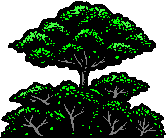

Home Page |
MICHIGAN FORESTS FOREVER TEACHERS GUIDE
| FOREST HEALTH ISSUES |  |
 Insects
& Diseases
Insects
& Diseases
Fire
Exotic Species
Forest Ecology Basics
Wildlife Ecology Basics
Some people will argue about the difference between "forest" health and "tree" health. One of the main issues is that poor tree health sometimes enhances overall forest health, to a limited degree. It does this by providing more habitat for species that benefit from trees in poor physical condition. This is often an argument made against forest management. For the most part, this section of the Teachers Guide will fall in line with the concept that forest management can never eliminate those elements of an ecosystem dependent upon trees in poor health, even if that were the only management objective. Forest management will increase the number of healthy trees growing vigorously, but will not significantly reduce ecosystem stability in the process. In fact, forest management generally enhances stability.
| Activity Suggestion PLT Trees In Trouble PLT Living With Fire Forest Pests & Exotics |
There are multitudes of insect and disease species that affect trees. Insects can be both beneficial and harmful. Diseases, by definition, are always harmful to trees, even if the harm is minor.
What is an insect?
What is a disease?
Insects and diseases are often evolved to affect only a certain part of a tree. Wood borers chew through the wood. Shoot beetles attack the young shoots of pine, leaf miners eat leaves, a fungus may attack only phloem, etc. Diseases, alone, are responsible for more wood loss than any other damaging agent, and exceeds volumes from timber harvests. Often times, a species of insect or disease is specific to a species or genus of tree.
The life cycles of insects and disease are fascinating and quite variable. Population levels are often strongly influenced by weather, seasons, parasites & predators, and the overall vigor of trees in the forest. In dry years, wood borers are usually more numerous because conifers are stressed and more vulnerable to wood borer attack. Some insects are cyclical. Forest tent caterpillar outbreaks occur about every ten years. Spruce budworm reaches epidemic proportions every 40 or 50 years, about the time balsam fir becomes mature and starts to lose vigor.
Damaging insects are often grouped by the kind of damage they cause or the part of the tree they attack.
| Defoliators | Leaf eaters, either the whole leaf or just the interior layers of a leaf. |
| Bark Beetles | Tunnels under bark, consuming live tissue. |
| Bark Borers | Tunnels in wood, consuming dead tissue. |
| Terminal Feeders | Eats the young growing tissue of twigs and roots. |
| Sucking Insects | Have specialized mouth parts to penetrate tissues and suck sap. |
| Gall Insects | Produces chemicals causing the tree to from an abnormal swelling, within which the insect carries out part of its life cycle. |
Some of the more common or important forest-damaging insects are:
| jack pine budworm spruce budworm sawflies loopers spanworms cankerworms large aspen tortrix forest tent caterpillar gypsy moth leafminers two-spotted sawyer beetle emerald ash borer |
pine sawyer beetle bronze birch borer sugar maple borer two-line chestnut borer white pine tip weevil pine shoot borer beech bark scale beech bark disease aphids spruce gall adelgid bark beetles carpenter ants |
woolly hemlock adelgid larch casebearer Saratoga spittlebug scale insects thrips
|
Diseases, too, are sometimes specialized in where they attack a tree. Most diseases are fungi, but some can be viral or bacterial. Decay is a normal and essential part of forest ecology and most of the fungi are key players in this vital role. For example, white rots attack the cellulose of wood, but leave most of the lignins and other components behind. The brown rots then move in, and decompose the lignins. Most fungi are not harmful to trees, or at least not healthy, vigorous trees. In fact, mychorrhizal fungi are beneficial and possibility critical to tree health. Generally, the spores and hyphae (living filaments) of fungi cannot penetrate the protective bark layers. A number of different fungi consume particular components of wood. Others may attack foliage or cambium tissues. Interestingly, trees cannot heal wounds like animals. Once wounded, the wound remains throughout the life of the tree. The best a tree can do is grow over the wound. Open wounds are not protected by bark and are open to infection by diseases.
Some of the more common or important forest-damaging diseases are:
| Anthracnoses Armillaria Black Knot of Cherry Dutch elm disease Eutypella Heart Rots Nectria Oak Wilt White Pine Blister Rust Mistletoe Needlecasts & blights Beech Bark Disease |
Attacks leaves and twigs during moist
periods. A common root rot. The famous "humungous fungus" of Crystal Falls. Charcoal-black swelling common on species of cherry. Attacks the cambium tissue, girdling the tree. Causes cankers on tree trunks. Decomposes wood tissue and forms large "conks" on trees. Cause cankers on tree trunks, similar to Eutypella. Related to Dutch elm disease and kills the same way. Attacks cambium tissue, can girdle and kill tree. A parasitic plant. Attacks conifer needles, sometimes the young, sometimes the old. Combination of exotic scale insect and exotic canker. Newly identified in 2002, this exotic insect poses threats to trees. |
A great website that has detailed information about many of our most common forest-damaging insects and diseases is maintained by the U.S. Forest Service and the U.P. Tree Identification website has many common to Michigan..
In addition to insects and disease, there are other pests and damaging agents that affect trees and forests, such as air and salt pollution, especially along major travel routes, browsing by deer and other animals, girdling by porcupines, nematodes (a group of worms), frost, hail and ice, wind, freezing, and sun scorch. As our forests age and mature, certain forest types will become much more vulnerable to forest health problems.
Back to TOP of the Page.
Wildfire is considered a bad thing because it destroys standing timber, buildings, and radically changes the face of the landscape in an uncontrolled manner. Ever since the huge Michigan fires in the late 1880s and early 1900s, fire suppression has been a major objective in forest management. That has not changed. However, fire has long been a part of the forest ecosystem. Forests, and in particular some tree species, have adapted to the presence of fire. Despite a negative image and negative effects, fire actually provides many benefits to certain forest types.
| Case Study: Jack pine is often used as a classic beneficiary of fire. About 75% of jack pine cones are "serotinous", meaning that they are "glued" shut. A temperature around 120 degrees will "melt" the glue and allow seeds to fall from the cones. Within a day or two of a fire, jack pine cones open and release their seeds. The seeds require the exposed mineral soil created by the fire. Jack pine are quite intolerant of shade, so the open, fire-killed canopy allows the light that the new trees need to grow. |
Some forest management practices (especially clearcutting) have filled the role of wildfire in many ways, but not all ways. Because management cannot use non-fire practices to imitate all the beneficial aspects of fire, foresters will prescribe fire in certain circumstances.
Prescribed fires can reduce the amount of fuel, therefore reducing the chance of a catastrophic wildfire. Also, smoke intensity from lighter fires will be less than with a major fire. Fire can burn off the dead leaves and expose mineral soil that some tree seeds need to germinate. Burning the dead leaves also eliminates habitat for some kinds of tree-damaging fungi and insects. The ash provides a short-term boost in potassium and other nutrients needed by trees. Fire can increase the amount of herbs, providing better browse for some species of wildlife.
Sometimes a prescribed fire will be used after a timber harvest. This way, the benefits of fire can be realized without destroying the standing timber. Of course, the downside is the perception of wanton forest destruction. Other times, prescribed fire will be used under a living canopy. For example, larger red pine have thicker bark, which a light fire cannot penetrate. A light fire will kill the smaller trees and shrubs. These living shrubs provide a "ladder" for a cone-boring beetle that destroys the seed of red pine while it is still in the cone. Foresters may prescribe one or two light underburns to prepare a mature red pine stand for partial harvest, and at the same time, create the kind of forest conditions to naturally regenerate red pine.
Back to TOP of the Page.
An exotic species is one that has been introduced from somewhere else and was not part of the natural development of the ecosystems in question. So, a species from Europe or Asia that is surviving in North America would be an exotic. The same would be true of a species from Colorado that now grows in Michigan.
An invasive species is one that aggressively colonizes new areas. It usually refers to exotic species that can rapidly overtake and disrupt native habitats. However, Pennsylvania sedge, a native, rapidly dominates the ground flora as deer, in high densities, eat just about everything else. Purple loosestrife (an exotic) has a beautiful flower but the plant overtakes wetlands. Common and smooth buckthorn (exotics) dominate sunny understories preventing the regeneration of most native species. Chestnut blight (an exotic) virtually eliminated the chestnut tree from the eastern forest where it once was a dominant native species.
| Exotic | Date Found | Origin |
| Chestnut Blight Dutch Elm Disease White Pine Blister Rust Beech Scale Birch Leafminer Larch Sawfly Gypsy Moth Pine Shoot Beetle Asian Longhorned Beetle Emerald Ash Borer Hemlock Woolly Adelgid |
1904 1930 1906 1890 1923 1880 1869 1992 1996 2002 2006 |
Asia Europe Europe Europe Europe Eurasia Europe Europe Asia Asia Europe |
To become a problem, an exotic species must reach new territory, become established (growing & breeding), and then spread. This is difficult to do in a foreign ecosystem. The overwhelming majority of introductions fail. Nevertheless, scientists estimate over 40,000 species have been introduced to North America.
Many exotics are not considered problematic and most are not damaging, such as cattle or carrots. How many realize that Great Lakes salmon are exotic? Or, pheasants? Or, honeybees?
About 400 insects and 20 diseases are exotic pests of trees. Most exotics have historically come from Europe. Mushrooming trade with China and other east Asian countries present an entirely new threat on the horizon.
Why are some exotics so bad? In terms of forests . . .
1. Negative effects on native species diversity.
2. Altered diversity can disrupt ecological processes, such as food chains, habitat
quality, etc.
3. Major outbreaks can reduce forest productivity across a wide geographical region.
4. Can further threaten endangered species.
5. Necessary quarantines and regulations can significantly reduce economic growth.
6. Control measures cost millions of dollars each year.
Many natural resource professionals consider exotics species one of the top threats to our forests and other native ecosystems.
 |
This website was developed and created by Michigan State University Extension for the teachers of the State of Michigan. |